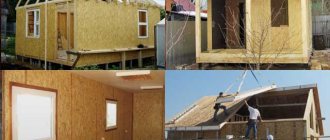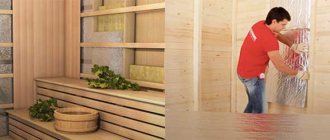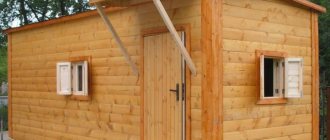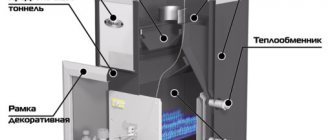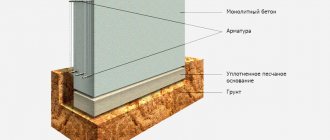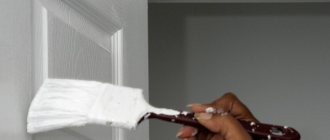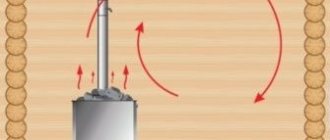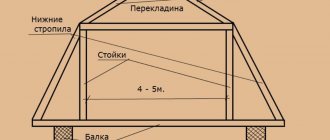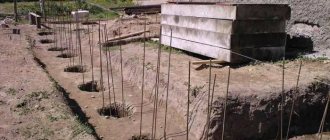23.12.2013
A sandwich chimney is one of the best options for removing smoke from fuel combustion in wood-burning sauna stoves. Currently, there are many design solutions for chimney devices in wooden buildings. And this applies primarily to the bathhouse with its main room - the steam room.
This article will present a chimney system using double-walled flue pipes (sandwiches) made of stainless steel. In addition, based on the presented drawings, important nuances and technology for installing a chimney with your own hands will be discussed, with a description of common mistakes.
- Chimney passage through a wooden interfloor ceiling
Chimney design
Based on the type of structure location, one can distinguish street (external) and internal chimneys. The street chimney channel goes outside through the wall. Its advantages: simple installation and high degree of fire safety. At the same time, it consumes more fuel and requires insulation.
The channel of the internal structure goes out through the roof and, as a rule, has a strictly vertical configuration without horizontal sections. It has good traction, consumes less fuel and heats up the steam room and sauna as a whole faster. Among the disadvantages, I note more labor-intensive repair and installation, a lower degree of fire safety in contrast to the external channel.
Design features
Chimneys for sauna stoves are constantly being improved; a variety of materials are used in their manufacture, and new technologies are emerging. Knowledge of the features of different modifications allows you to install them correctly, ensure the required fire safety measures, and ensure regular cleaning and replacement of components.
According to their configuration, chimneys can be internal or external. Domestic
, are brought out through the wall using adapters. The design allows you to save useful space in the room and eliminates the possibility of burns or fire of internal equipment. But there is also a minus - low efficiency - a considerable portion of the heat simply “leaves” into the atmosphere.
External
chimneys lead directly from the stove to the outside through the ceiling and roof. The required shape and direction are given through a variety of fittings, and safety is ensured by the correct selection of insulation in accordance with SNiP 41-01-2003.
Advantages and disadvantages of a sandwich chimney
The most common type of chimney for a bathhouse is sandwich pipes, which have a number of advantages:
- simple and easy installation, which you can even do yourself;
- high repairability due to standard parts;
- aesthetic appearance;
- high anti-corrosion ability;
- low heat transfer and low condensation due to the insulating layer;
- No soot is deposited on the inner surface of the sandwich pipe because this surface is smooth.
Despite their impressive track record of benefits, sandwiches also have their drawbacks:
- high cost compared to analogues;
- limited service life - up to 15 years;
- When heated, the joints may become depressurized due to metal expansion.
The materials from which it is made are of key importance for a sandwich pipe. The price, service life and safety depend on the filling.
Cleaning the chimney
It is best to do this after it has rained. Chimney cleaning is an important process that should never be avoided or ignored. Experts advise resorting to a time-tested mechanical method for this using a brush, special weights, and sometimes a sledgehammer and a crowbar.
It is recommended to remove all things from the bathhouse and cover the floor, walls and ceiling, for example, with newspapers. This work is very dirty!
It is most convenient to use a brush to clean the pipe. It is inserted into the pipe and gently pushed upward until the resistance of the soot accumulated on the walls becomes less. The main thing is not to twist the brush, otherwise it can break. If this happens, then it will be possible to get it only in parts.
If you find small growths in the chimney, heat the stove with aspen wood.
Chimney cleaning
When burning, they create excellent draft and remove ash from the chimney. Aspen firewood is characterized by dry and intense heat. If the stove was previously heated with pine wood, then, most likely, resin substances remained on the walls, evaporating from the pine needles during the fire. Aspen will perfectly eliminate them too. Instead of aspen, it is permissible to use potato peelings, which cope with the same problems no worse. The only problem is collecting them in the required quantity.
In addition to the mechanical method of cleaning pipes, there are also more modern ones. They are rapidly gaining popularity. Cleaning occurs with the help of chemicals, which contain special substances that, during combustion, remove soot from the chimney or make it loose, due to which it falls off on its own.
What materials are they made from?
The sandwich pipe has 3 structural elements:
- External pipe. It can be made from various materials: stainless steel, copper, galvanized, steel.
- Inner pipe. It is carried out in a similar way to the outer pipe, but has a smaller diameter.
- The thermal insulation inter-pipe layer is made of cotton wool mineral heat insulator (basalt, stone wool, etc.).
I will dwell in more detail on the materials of the sauna pipe itself: it is this that determines the cost and operational capabilities of the sandwich chimney.
Steel
The steel sandwich is made of stainless alloy steel with high anti-corrosion ability. It is very technologically advanced and easily bends in different directions. It is light in weight, unlike, for example, a ceramic pipe. It can be equipped with cleaning hatches and spark-extinguishing grilles, which increase its safe operation. The optimal wall thickness is 1 mm. The pipe itself can be painted in any color, which allows you to decorate it organically.
Which is better: galvanized or stainless chimneys
Galvanization is cheaper than stainless steel, which is due to its lower ability to withstand mechanical damage. Even slight damage to the protective layer can lead to metal corrosion.
Some builders install a combined chimney to reduce costs and at the same time provide the necessary safety and reliability of the bathhouse pipe. Stainless steel is used to make a section in the steam room, where working conditions are more extreme. Galvanized pipe is used in the attic and outdoor areas.
With a combined installation, problems may arise with the joining of elements, so before reducing the budget for building a bathhouse, “measure” the consequences seven times!
Ceramic
Ceramic pipes have a number of advantages:
- High temperature resistance – up to 1200 °C.
- Eco-friendly: they are made from natural clay.
- Light weight in contrast to concrete and brick structures.
- Ease of use due to special ceramic modules, which are manufactured with cleaning doors.
The pipes themselves are compact three-layer modules 30 cm high. The inner layer is smooth, which promotes good traction and prevents combustion products from settling on it. They are easy to assemble into a solid and durable structure.
Glass
The main advantage of a glass pipe for a bath is its attractive and modern appearance. It is made of safety fire-resistant glass: when broken, it shatters into blunt fragments, which eliminates cuts. Glass pipes are durable, easy to clean, and resistant to temperature changes. Not everyone can install such a pipe, because its cost is much higher than chimneys made of sandwiches and other traditional materials.
I think that in the future they will become more affordable, but for now they are a designer luxury that can be abandoned in favor of budget options.
What material is best for a chimney in a bathhouse?
I have listed which pipes can be used to build a bathhouse. I dwelled on each type in detail, highlighting its pros and cons. Now let me clarify that it is not recommended for use in steam rooms.
These include concrete and asbestos-cement pipes: these structures do not comply with fire safety standards for premises with high-temperature operating conditions.
When choosing, take this recommendation into account; otherwise, decide for yourself according to your budget and aesthetic preferences.
Installation recommendations
It is prohibited to lay a horizontal part of the chimney longer than one meter. The total height of the outlet channel should be more than five meters, which will ensure stable and good traction.
It is prohibited to carry out work with tools that do not have rubberized insulating surfaces. The layout of the structure is worked out in advance. When installing chimneys for a stove in a bathhouse, several important rules are followed:
- The pipe should not come into contact with furniture, wallpaper, electrical wiring or other communications.
- An empty space is left between the ceiling and the sheathing (more than 30 cm for uninsulated pipes and at least 15 cm if there is insulation).
- Contact of the chimney and wood with the exhaust channel is not allowed.
- If the pipe is laid through an unheated attic, thermal insulation is used to prevent condensation.
- Do not place the chimney near combustible or flammable materials.
- When planning the exhaust system, the number of components is taken into account, depending on the height of the device.
Contact of the chimney with any surfaces is excluded Source rinnipool.ru
This might be interesting!
In the article at the following link, read about a 6x8 bathhouse with an attic.
Buy or make it yourself
Buying a chimney for a bathhouse is easier than making it correctly yourself. But simpler does not mean better, especially if you have the necessary skill, free time and a desire to save money. With the right approach, making a good design will not be difficult. You can use a compromise option: make some elements yourself, and buy some complex components.
approximate price
How much a pipe for a bathhouse costs depends on the number of offers in a particular region of the country, what size the bathhouse itself is, etc.
I collected average market prices so that preliminary calculations could be made.
Basic requirements for a chimney in a bathhouse
The chimney is subject to increased fire safety requirements, because it gets very hot and can cause a fire in the bathhouse. To avoid negative consequences, during assembly and operation you must adhere to simple but important rules:
- 250 mm from the pipe is the permissible distance for placing flammable objects.
- The walls near the stove must be made of fire-resistant materials: fireclay bricks, sheet steel, etc.
- It is not recommended to sprinkle the channel with bulk materials so as not to disturb the air cooling of the structure.
- To prevent fire from sparks, the edge of the pipe must be at the required distance from the roof.
How to make a chimney in a bathhouse with your own hands: step-by-step instructions
The easiest way to assemble a bath channel is from sandwiches. When assembling, there are several nuances that are worth considering so as not to get into trouble:
- Docking of modules must take place in visible areas and is strictly prohibited during ceiling or roof penetrations.
- The optimal size of the horizontal section is up to 100 cm in length, otherwise traction may deteriorate significantly.
Following these two simple rules will help you avoid thousands of negative consequences.
Required tools and materials
To assemble a sandwich structure for a bathhouse, you will need the following materials:
- sandwich modules according to the project (drawing);
- elements for the arrangement of cutting in the interfloor slab and roof passage;
- cotton wool mineral thermal insulation;
- if the sandwich channel for a bath has a complex configuration and horizontal sections, then various adapters will be needed;
- fasteners (screws, ties);
- sealant for sealing joints;
- head.
For high-quality installation you will also need a set of tools. A standard list should include:
- jigsaw;
- drill and screwdriver, or an electric screwdriver;
- skeleton gun for sealant;
- set of chisels;
- level and tape measure at least 5 m, otherwise there will be inconvenience and loss of time during measurements;
- metal scissors.
Design, drawings and diagrams
At the design stage, it is worth considering several common truths:
- The height of the chimney structure to ensure normal operation is at least 450 cm.
- The distance from the edge of the channel to the plane of the roof slope is at least 50 cm.
- The channel must be equipped with a valve (gate, valve) to regulate draft.
- Passage units in the floors and roof of the bathhouse must be thermally insulated.
- The simpler the configuration (the course of the pipe for the bath), the cheaper and more convenient it is!
There are also folk life hacks. For example, paint the outer surface of the pipe with white or light paint to easily detect leaks through which smoke is coming.
Before assembly, it is important to make a drawing or diagram. Below are two diagrams of a chimney made from sandwiches, which can also be used for a bathhouse.
Diagram of the external (external) channel
Internal channel diagram
Methods for connecting modular elements in a chimney
Sandwich modules can be connected in two ways:
- "By the smoke." This connection prevents smoke and carbon monoxide from entering the room. The lower module is inserted into the upper one so that the edge of the lower one is higher than the edge of the upper one, as shown in the right figure.
- "By condensate." This option prevents condensate from entering the heat insulator of the sandwich pipe. To do this, the upper module is inserted into the lower one so that the edge of the upper one is inserted below the edge of the lower one, as shown in the left figure.
Assembly order
Before installing the sandwich pipe in the bathhouse, passages in the ceiling and roof are prepared. If the cutting of the ceiling-passage assembly (CPU) should be done immediately, then it is better to make a hole in the roof with the sandwich pipe directly approaching it. This way you can prevent the premises from getting wet during rain, as well as unnecessary work on closing the hole itself.
After installing the PPU, you can begin assembling the sandwich line:
- To accelerate heating of the steam room, a steel pipe is immediately installed, and the sandwich is installed closer to the ceiling at a distance of 20–30 cm
- You should not join modules in passage units, otherwise to repair them you will need to disassemble the polyurethane foam or the passage in the roof.
- It is better to install sandwiches for a bathhouse “in the smoke” to protect the health of steamers.
- The joints of the modules are sealed with heat-resistant sealant.
- The roof hole is closed with a flash master with a silicone lining, which seals the roof hole.
Light weight and simple joining of sandwich pipes allow two craftsmen to install them in a short time. You can even assemble a sandwich pipe for a bathhouse yourself, but it is better to call a competent friend or acquaintance to avoid amateurish mistakes.
Chimney passage through a wooden interfloor ceiling
The ceiling-passage assembly (CPU) in wooden floors should be carried out in accordance with SNiP, which sets out the following rules:
- The PPU sleeve is made of non-flammable material, see SNIP for the classification of materials.
- The cutting (the passage of the pipe through the ceiling) is made of fire-resistant materials (basalt wool, etc.).
- The cutting for wooden floors is made with a width of 50 cm.
- The cross-section of the sleeve must be wider than the diameter of the channel to ensure convenient installation.
- You should not use a rigid groove connection with an overlap to prevent channel bending.
- The setback (distance between the pipe and the adjacent wall) for wooden walls is 26–50 cm.
Compliance with these simple rules will ensure the safe operation of the bathhouse chimney and the health of bathhouse attendants and steamers.
Chimney passage through a roof with a roof made of combustible materials
The channel through the roof is carried out as follows:
- Marking and cutting of the roof is done in such a way that there is at least 130 mm from the outer layer of the pipe to the edge of the roof.
- If the roof is insulated, then under-roof and top plates are installed, and the space itself is filled with a heat insulator.
- If the roof is cold, then it is enough to install a flash master.
- The outer cover or flash master at the junction with the roof is coated with bitumen sealant.
Output through the ceiling
Installation of a chimney in a bathhouse through the ceiling is carried out as follows.
For the exit, a special unit is installed in the ceiling covering, which creates reliable fastening and high fire safety: Despite the fact that such a pipe is a two-layer structure with non-flammable thermal insulation in the middle, to increase the level of safety, a hole is made in the ceiling opening for the chimney installation of a small pipe, which is 15-20 cm in diameter larger than the diameter of the chimney.
From the bottom, such a hole is sealed with a steel sheet. The part that ends up in the attic is filled with non-combustible material. To do this you can take:
- basalt wool;
- sand;
- expanded clay
A large-volume rolled pipe range for insulating a sandwich chimney can be replaced with a box made of non-combustible materials:
A sandwich - a smoke exhaust - is passed into the box, and the empty space is also filled with non-flammable material:
The video provided details how such work is carried out.
